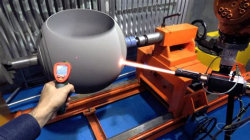High-velocity oxygen fuel (HVOF) processes are characterised by a combination of high heat and high velocity. The HVOF technique improves the quality of coatings by reducing oxide content. These properties are achieved through a combination of high velocities and low flame temperatures. The high kinetic energy of the particles that strike the substrate leads to the formation of a dense and strong coating. The process is remarkably similar to that of combustion powder spray, though the particle velocity of the process allows for much higher adhesion. Find out more about HVOF at a site like https://www.poeton.co.uk/standard-treatments/plasma-coatings

The HVOF process produces a supersonic gas stream for the coating material. This gas stream carries the coating material at high velocity. The combustion arc generates a high pressure, which enables the particles to fly at near-supersonic speeds. As the particle velocity increases, the surface is coated with a thin, overlapping layer of coating material. This high-pressure treatment provides a durable coating that will last for a long time.
This method is a high-pressure, high-velocity thermal spraying process. The high-velocity gas stream is accelerated through a nozzle. The resulting coating material consists of thin overlapping platelets that are bonded to the surface. The high-velocity gas stream also provides a high bonding strength and excellent exertion. The particles are melted as the gases and oxygen mix.
The HVOF process is a spray coating process that uses an oxygen-fueled combustion chamber to create a high-pressure, high-speed flame. A combustible gas stream combines hydrogen and oxygen to form a gas with a very high density. This process can deliver a coating to a higher density than is typical for thermal spray coatings. Increasing the bond strength of HVOF coatings also helps prolong equipment and product life.

A high-velocity oxygen-fuel process can improve component surface properties, dimensions, and wear resistance. It can be used on metals and ceramics in a thermal spraying process. Unlike a thermal spraying process, HVOF coatings are very hard and provide a high level of wear and corrosion resistance. The coating can withstand extreme temperatures and will last for years. When it comes to HVOF, the application of a ceramic or cobalt-coated metal is crucial for many industrial applications.
Another difference between a thermal spray process and an HVOF process is its efficiency. It uses liquid fuel to apply coatings. The oxygen and fuel are mixed in a gas mixture and the gas and oxygen are heated in an arc. The pressure and temperature of the gas will be high, which will give the coating its high quality. Once the application is complete, the coating is applied at a higher speed and in more concentrated areas, making it the ideal choice for many industrial applications.
